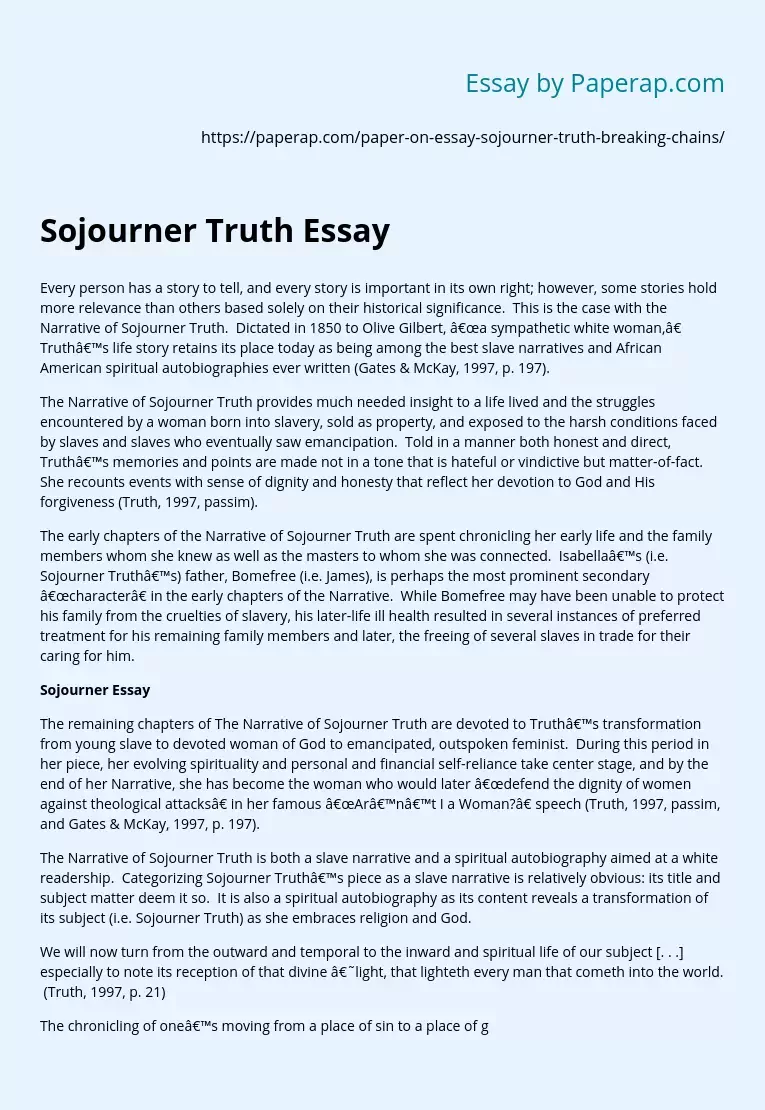Sojourner Truth Essay
Every person has a story to tell, and every story is important in its own right; however, some stories hold more relevance than others based solely on their historical significance. This is the case with the Narrative of Sojourner Truth. Dictated in 1850 to Olive Gilbert, “a sympathetic white woman,” Truth’s life story retains its place today as being among the best slave narratives and African American spiritual autobiographies ever written (Gates & McKay, 1997, p. 197).
The Narrative of Sojourner Truth provides much needed insight to a life lived and the struggles encountered by a woman born into slavery, sold as property, and exposed to the harsh conditions faced by slaves and slaves who eventually saw emancipation.
Told in a manner both honest and direct, Truth’s memories and points are made not in a tone that is hateful or vindictive but matter-of-fact. She recounts events with sense of dignity and honesty that reflect her devotion to God and His forgiveness (Truth, 1997, passim).
The early chapters of the Narrative of Sojourner Truth are spent chronicling her early life and the family members whom she knew as well as the masters to whom she was connected. Isabella’s (i.e. Sojourner Truth’s) father, Bomefree (i.e. James), is perhaps the most prominent secondary “character” in the early chapters of the Narrative. While Bomefree may have been unable to protect his family from the cruelties of slavery, his later-life ill health resulted in several instances of preferred treatment for his remaining family members and later, the freeing of several slaves in trade for their caring for him.
The remaining chapters of The Narrative of Sojourner Truth are devoted to Truth’s transformation from young slave to devoted woman of God to emancipated, outspoken feminist. During this period in her piece, her evolving spirituality and personal and financial self-reliance take center stage, and by the end of her Narrative, she has become the woman who would later “defend the dignity of women against theological attacks” in her famous “Ar’n’t I a Woman?” speech (Truth, 1997, passim, and Gates & McKay, 1997, p. 197).
The Narrative of Sojourner Truth is both a slave narrative and a spiritual autobiography aimed at a white readership. Categorizing Sojourner Truth’s piece as a slave narrative is relatively obvious: its title and subject matter deem it so. It is also a spiritual autobiography as its content reveals a transformation of its subject (i.e. Sojourner Truth) as she embraces religion and God.
We will now turn from the outward and temporal to the inward and spiritual life of our subject [. . .] especially to note its reception of that divine ‘light, that lighteth every man that cometh into the world. (Truth, 1997, p. 21)
The chronicling of one’s moving from a place of sin to a place of grace is what makes an autobiography “spiritual” (Sim). The intended audience can be ascertained in two ways: first, like Truth, the majority of blacks could neither read nor write, so they would have little if any access to the work; second, the numerous certifications of character that are included in the piece include William Lloyd Garrison, one of the most famous figures of the anti-slavery movement and the publisher of The Liberator (Sicker). Proving the veracity of a black woman’s recollected life would only be relevant to a white audience: a black audience would recognize themselves in the experiences of Sojourner Truth.
The Narrative of Sojourner Truth is historically significant for two major reasons. First, Sojourner Truth’s piece follows the life of a female slave and serves as a necessary companion to Frederick Douglass’ well-known narrative. Without Truth’s piece, the level of intellect and perseverance of enslaved black women might not be adequately acknowledged.
Sojourner Truth Essay. (2019, Dec 05). Retrieved from https://paperap.com/paper-on-essay-sojourner-truth-breaking-chains/

